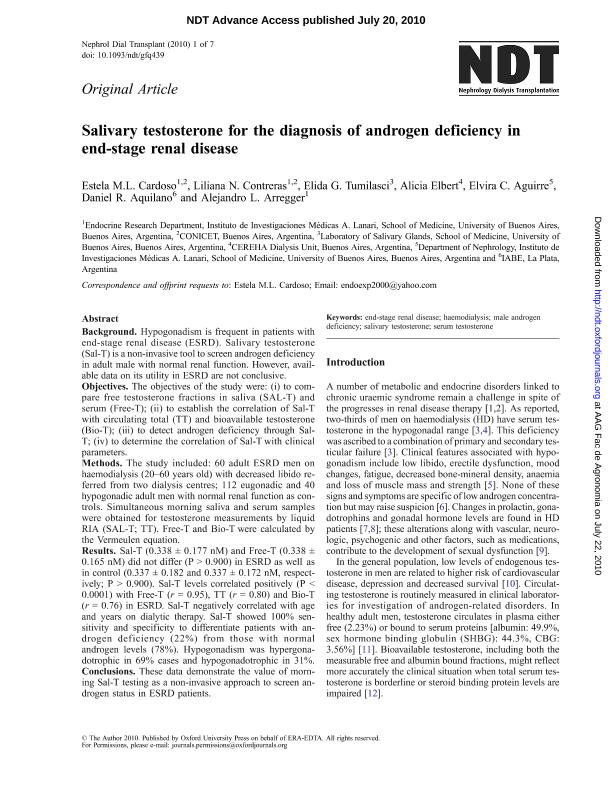Artículo
Salivary testosterone for the diagnosis of androgen deficiency in end-stage renal disease
Cardoso, Estela M.del Lujan ; Contreras, Liliana; Tumilasci, Elida G.; Elbert, Alicia; Aguirre, Elvira C.; Aquilano, Daniel R.; Arregger, Alejandro Luis
; Contreras, Liliana; Tumilasci, Elida G.; Elbert, Alicia; Aguirre, Elvira C.; Aquilano, Daniel R.; Arregger, Alejandro Luis
 ; Contreras, Liliana; Tumilasci, Elida G.; Elbert, Alicia; Aguirre, Elvira C.; Aquilano, Daniel R.; Arregger, Alejandro Luis
; Contreras, Liliana; Tumilasci, Elida G.; Elbert, Alicia; Aguirre, Elvira C.; Aquilano, Daniel R.; Arregger, Alejandro Luis
Fecha de publicación:
07/2011
Editorial:
Oxford University Press
Revista:
Nephrology Dialysis Transplantation
ISSN:
0931-0509
Idioma:
Inglés
Tipo de recurso:
Artículo publicado
Clasificación temática:
Resumen
BACKGROUND: Hypogonadism is frequent in patients with end-stage renal disease (ESRD). Salivary testosterone (Sal-T) is a non-invasive tool to screen androgen deficiency in adult male with normal renal function. However, available data on its utility in ESRD are not conclusive. OBJECTIVES: The objectives of the study were: (i) to compare free testosterone fractions in saliva (SAL-T) and serum (Free-T); (ii) to establish the correlation of Sal-T with circulating total (TT) and bioavailable testosterone (Bio-T); (iii) to detect androgen deficiency through SalT; (iv) to determine the correlation of Sal-T with clinical parameters. METHODS: The study included: 60 adult ESRD men on haemodialysis (20–60 years old) with decreased libido referred from two dialysis centres; 112 eugonadic and 40 hypogonadic adult men with normal renal function as controls. Simultaneous morning saliva and serum samples were obtained for testosterone measurements by liquid RIA (SAL-T; TT). Free-T and Bio-T were calculated by the Vermeulen equation. RESULTS: Sal-T (0.338 ± 0.177 nM) and Free-T (0.338 ± 0.165 nM) did not differ (P > 0.900) in ESRD as well as in control (0.337 ± 0.182 and 0.337 ± 0.172 nM, respectively; P > 0.900). Sal-T levels correlated positively (P < 0.0001) with Free-T (r = 0.95), TT (r = 0.80) and Bio-T (r = 0.76) in ESRD. Sal-T negatively correlated with age and years on dialytic therapy. Sal-T showed 100% sensitivity and specificity to differentiate patients with androgen deficiency (22%) from those with normal androgen levels (78%). Hypogonadism was hypergonadotrophic in 69% cases and hypogonadotrophic in 31%. CONCLUSIONS: These data demonstrate the value of morning Sal-T testing as a non-invasive approach to screen androgen status in ESRD patients.
Archivos asociados
Licencia
Identificadores
Colecciones
Articulos(IDIM)
Articulos de INST.DE INVEST.MEDICAS
Articulos de INST.DE INVEST.MEDICAS
Citación
Cardoso, Estela M.del Lujan; Contreras, Liliana; Tumilasci, Elida G.; Elbert, Alicia; Aguirre, Elvira C.; et al.; Salivary testosterone for the diagnosis of androgen deficiency in end-stage renal disease; Oxford University Press; Nephrology Dialysis Transplantation; 26; 2; 7-2011; 667-683
Compartir
Altmétricas



